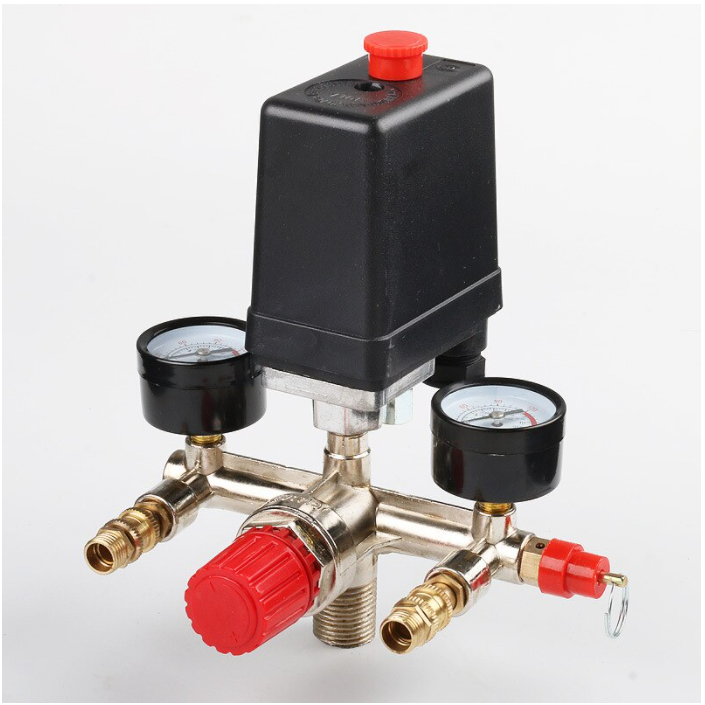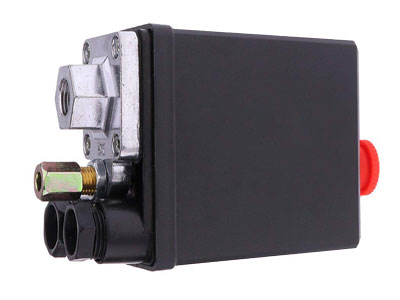Pressure switches are pressure-actuated electrical switches. Wich simply means, that there is an electrical switch, which is forced open or closed by air pressure.
The air compressor cut off switch at the inlet port acts on a flexible membrane. The pressure is transformed into a force. How much force depends on two things: the area (square mm’s) of the membrane and the pressure (bar) of the compressed air. Since the area is constant, the force generated is directly proportional to the air pressure.
The other side of the membrane is connected to a spring and a lever that acts on the electrical switch. As long as the downward force of the spring is higher than the upward force of the compressed air, the membrane (and lever) stay down.
But when the pressure rises, there comes a point where the upward force of the compressed air is higher than the downward force of the spring. The membrane (and lever) will move upward at this point. When the membrane moves upward, so does the lever. The lever, in turn, opens the electrical contacts and the compressor stops.
Now, this isn’t a direct connection, but there is an ingenious mechanism inside, that makes the switch flip-over at once, at a certain pressure, and not slowly (“snap-action”). This mechanism is also connected to the second set-screw which sets the differential pressure. For the inner workings of the pressure switch, this simply means that the switch closes again at a lower pressure than the pressure where the switch closes (built-in hysteresis).
Transmitter
LEFOO Industrial Co., Ltd, a professional manufacturer of LF10-L pressure switch (0.5-1.2MPa / 72.5-174 psi)
The LF10-L pressure switch is a pressure-operated electric switch for use in regulating the tank pressure between two preset values on electrically driven air compressors. It is available with an unloader valve, which prevents compressors from starting under load, and an On-Off button for manual cut off the compressor. A four-port manifold style is available which provides a means for easy mounting of valves and gauges.
Specification
MODEL | LF10-L1H | LF10-L4H |
Medium | Air | Air |
Operating Pressure Range | 0.5~1.2Mpa | 0.5~1.2Mpa |
Differential Pressure | 0.2Mpa | 0.2Mpa |
Factory Setting | 0.6~0.8 Mpa | 0.6~0.8 Mpa |
Operating Temperature Range | -30~55C° C | -30~55° C |
Electrical Rating | 240V,20A, 50Hz | 240V,20A, 50Hz |
Contact Arrangement | Normally Open(NC) | Normally Open(NC) |
Port | one port | four ports |
Pipe Fittings | G1/4, G3/8 or 1/4, 3/8 NPT Female | G1/4, G3/8 or 1/4, 3/8 NPT Female |
Approval: UL, CUL, CE , CCC
Other Pressure Swettings and Differential are available on request.
Conversion: 1Mpa =10.2 Kgf/cm2 , Kgf/cm2 = 14.2PSI , 1bar = 14.5PSI
A pressure switch is a standard component of an air compressor, and its main function is to tell the compressor when to start and when to stop. Selecting the right pressure switch is simple when you know what to look out for.
The pressure at which a pressure switch opens is the cut-out pressure and the pressure at which a pressure switch closes is the cut-in pressure.
The cut-in pressure should always be the lowest allowable pressure in your air system. If, for example, your equipment needs 100 psi to operate, set the cut-out pressure above 100 psi.
Since you will always have some pressure drop in your compressed air system, and since it takes some time for the compressor to 'kick in', it's better to set the cut-in pressure 10 psi higher. In our example, we would set the pressure switch at 110 psi to allow for the pressure drop in our system.
The difference between the cut-in and the cut-out pressure is the pressure differential.

Pressure switches for air compressors come in different forms and shapes. Selecting the right model depends on what your needs are. Fixed pressure switches are usually a little cheaper, while fully adjustable pressure switches give you more freedom.
Some pressure switches have a fixed cut-in and cut-out pressure set-point. Other pressure switches have a fixed pressure differential, while the cut-in pressure can be adjusted. On other types of pressure switches, you can adjust both the cut-in and the cut-out pressure.
Finding a good replacement pressure switch
An exact replacement from the original manufacturer is often very expensive. It is usually much cheaper to find your own replacement switch.
Your new pressure switch doesn’t need to be exactly the same as the one that you’re replacing. However, you need to buy a pressure switch that has the same maximum pressure and electrical rating.
Here is a list of things to check before you select a pressure switch supplier
Is the maximum pressure rating equal or higher than the current one?
Your compressor is rated for a certain maximum pressure. Your new pressure switch must have either the same pressure rating or higher.
Also, be sure to never set the pressure setting higher than the maximum rated pressure of your compressor!
Can it handle the electrical load?
On smaller compressors (0 - 3 hp) the pressure switch will switch the compressor motor directly.
Your new pressure switch needs to be able to handle the motor currents of your compressor.
What are the physical compressed air connections?
What is the physical compressed air connections on your current pressure switch? You can always make an adapter, but it's easiest to buy a new pressure switch that fits directly on your compressor.
Common connection sizes are 1/4", 3/8" and 1/2" NPT female.
Does it have an on/off switch?
Some compressors have an on/off switch, some don't.
Bigger compressors usually don't have an on/off button on the pressure switch. Instead, they have a separate control panel where the control buttons (on/off, load/unload) are located.
Smaller compressors are switched on and off directly by the pressure switch. In this case, your pressure switch will most likely have an on/off button
Does the old pressure switch have an integrated unloader valve?
The unloader valve of reciprocating compressors is often located on the side or on the bottom of the pressure switch.
The new pressure switch that you buy must have the same connections (so you can re-use the old unloader valve), or then it should come with a new unloader valve.
If you buy a new pressure switch together with an unloader valve, make sure that the physical compressed air connection is the same.
Product Inquiry
12 Jun 2024
Unlocking Clean Water: How Booster Pumps Enhance Purification Systems29 May 2024
Improving Drug Formulation Accuracy with Stepper Motor Peristaltic Pumps24 May 2024
Meet LEFOO at SPS Italy 202415 May 2024
Precision and Hygiene: Stepper Motor Peristaltic Pumps in the Food Industry English
English  français
français  Deutsch
Deutsch  Español
Español  italiano
italiano  русский
русский  العربية
العربية 
